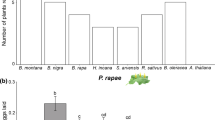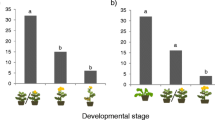Abstract
Butterfly-pollinated flowers offer nectar with higher amino acid concentrations than most flowers pollinated by other animals, and female butterflies of some species prefer to consume amino acid-rich nectar. However, for over 30 years, there has been an ongoing discussion about whether nectar amino acids benefit butterfly fitness. A clear positive effect was only shown for the nectar-feeding Araschnia levana, and females of the fruit-feeding Bicyclus anynana also increased offspring quality when they were fed amino acids as adults. Thus, severe doubts remain about the general significance of these single positive results. We therefore tested a further species from a phylogenetically different butterfly subfamily, the small heath (Coenonympha pamphilus L., Satyrinae), taking into account feeding conditions over the whole life cycle of this species. C. pamphilus females receiving nectar amino acids as adults, irrespective of larval food quality, produced heavier larvae and also increased the hatching success of their eggs over the oviposition period. Furthermore, females raised under nitrogen-poor larval conditions tended to use nectar amino acids to increase the number of eggs laid. Thus, C. pamphilus females used nectar amino acids primarily to increase their offspring quality, and secondly tended to increase offspring quantity, if larval resources were scarce, showing a resource allocation pattern differing from both B. anynana and A. levana. Our study supports the old postulate that nectar amino acids generally enhance butterfly fitness.



Similar content being viewed by others
References
Alm J, Ohnmeiss TE, Lanza J, Vriesenga L (1990) Preference of cabbage white butterflies and honey bees for nectar that contains amino acids. Oecologia 84:53–57
Arnqvist G, Nilsson T (2000) The evolution of polyandry: multiple mating and female fitness in insects. Anim Behav 60:145–164. doi:10.1006/anbe.2000.1446
Baker HG (1975) Sugar concentrations in nectars from hummingbird flowers. Biotropica 7:37–41
Baker HG, Baker I (1973) Amino-acids in nectar and their evolutionary significance. Nature 241:543–545
Baker HG, Baker I (1975) Studies of nectar-constitution and pollinator-plant coevolution. In: Gilbert LE, Raven PH (eds) Coevolution of animals and plants. University of Texas Press, Austin, pp 100–140
Baker HG, Baker I (1986) The occurrence and significance of amino acids in floral nectar. Plant Syst Evol 151:175–186
Bauerfeind SS, Fischer K (2007) Effects of adult nutrition on female reproduction in a fruit-feeding butterfly: The role of fruit decay and dietary lipids. J Insect Physiol 53:964–973. doi:10.1016/j.jinsphys.2007.01.013
Bauerfeind SS, Fischer K (2009) Effects of larval starvation and adult diet derived amino acids on reproduction in a fruit-feeding butterfly. Entomol Exp Appl 130:229–237. doi:10.1111/j.1570-7458.2008.00814.x
Boggs CL (1981) Nutritional and life-history determinants of resource allocation in holometabolous insects. Am Nat 117:692–709
Boggs CL (1997a) Dynamics of reproductive allocation from juvenile and adult feeding: radiotracer studies. Ecology 78:192–202
Boggs CL (1997b) Reproductive allocation from reserves and income in butterfly species with differing adult diets. Ecology 78:181–191
Boggs CL (2009) Understanding insect life histories and senescence through a resource allocation lens. Funct Ecol 23:27–37. doi:10.1111/j.1365-2435.2008.01527.x
Boggs CL, Freeman KD (2005) Larval food limitation in butterflies: effects on adult resource allocation and fitness. Oecologia 144:353–361. doi:10.1007/s00442-005-0076-6
Boggs CL, Gilbert LE (1979) Male contribution to egg production in butterflies: evidence for transfer of nutrients at mating. Science 206:83–84
Boggs CL, Ross CL (1993) The effect of adult food limitation on the life history traits in Speyeria mormonia (Lepidoptera: Nymphalidae). Ecology 74:433–441
Braby MF (1994) The significance of egg size variation in butterflies in relation to hostplant quality. Oikos 71:119–129
Carvalho GB, Kapahi P, Benzer S (2005) Compensatory ingestion upon dietary restriction in Drosophila melanogaster. Nat Methods 2:813–815. doi:10.1038/nmeth798
Casas J, Pincebourde S, Mandon N, Vannier F, Poujol R, Giron D (2005) Lifetime nutrient dynamics reveal simultaneous capital and income breeding in a parasitoid. Ecology 86:545–554. doi:10.1890/04-0812
Crawley MJ (2007) The R book. Wiley, West Sussex
Dadd RH (1973) Insect nutrition: Current developments and metabolic implications. Annu Rev Entomol 18:381–420
Dunlap-Pianka H, Boggs CL, Gilbert LE (1977) Ovarian dynamics in heliconiine butterflies: programmed senescence versus eternal youth. Science 197:487–490
Ebert G, Rennwald E (1991) Die Schmetterlinge Baden-Württembergs. Eugen Ulmer, Stuttgrad
Engleman F (1984) Ecological Entomology. Wiley, New York
Erhardt A (1991) Nectar sugar and amino acid preferences of Battus philenor (Lepidoptera, Papilionidae). Ecol Entomol 16:425–434
Erhardt A (1992) Preferences and non-preferences for nectar constituents in Ornithoptera priamus poseidon (Lepidoptera, Papilionidae). Oecologia 90:581–585
Erhardt A, Rusterholz HP (1998) Do peacock butterflies (Inachis io L.) detect and prefer nectar amino acids and other nitrogenous compounds? Oecologia 117:536–542
Fischer K, Zwaan BJ, Brakefield PM (2002) How does egg size relate to body size in butterflies? Oecologia 3:375–379. doi:10.1007/s00442-002-0913-9
Fischer K, Bot ANM, Brakefield PM, Zwaan BJ (2003) Fitness consequences of temperature-mediated egg size plasticity in a butterfly. Funct Ecol 17:803–810
Fischer K, Bot ANM, Brakefield PM, Zwaan BJ (2006) Do mothers producing large offspring have to sacrifice fecundity? J Evolution Biol 19:380–391. doi:10.1111/j.1420-9101.2005.01046.x
Garcia-Barros E (2000) Body size, egg size and their interspecific relationships with ecological and life history traits in butterflies (Lepidoptera: Papilionoidea, Hesperoidea). Biol J Linn Soc 70:251–284
Geister TL, Lorenz MW, Hoffmann KH, Fischer K (2008) Adult nutrition and butterfly fitness: effects of diet quality on reproductive output, egg composition, and egg hatching success. Front Zool 5:10. doi:10.1186/1742-9994-5-10
Goverde M, Erhardt A (2003) Effects of elevated CO2 on development and larval food-plant preference in the butterfly Coenonympha pamphilus (Lepidoptera, Satyridae). Glob Change Biol 9:74–83. doi:10.1007/s00265-003-0601-8
Hill CJ (1989) The effect of adult diet on the biology of butterflies. II. The common crow butterfly, Euploea core corinna. Oecologia 81:258–266
Jervis MA, Boggs CL (2005) Linking nectar amino acids to fitness in female butterflies. Trends Ecol Evol 20:585–587. doi:10.1016/j.tree.2005.08.015
Karlsson B (1998) Nuptial gifts, resource budgets, and reproductive output in a polyandrous butterfly. Ecology 79:2931–2940
Karlsson B, Wiklund C (1984) Egg weight variation and lack of correlation between egg weight and offspring fitness in the wall brown butterfly, Lasiommata megera. Oikos 43:376–385
Karlsson B, Wiklund C (2005) Butterfly life history and temperature adaptations; dry open habitats select for increased fecundity and longevity. J Anim Ecol 74:99–104. doi:10.1111/j.1365-2656.2004.00902.x
Koch M (1991) Schmetterlinge. Neumann, Radebeul, pp 138–139
Lüttge U (1961) Über die zusammensetzung des nektars und den mechanismus seiner sekretion. I. Planta 56:189–212
Mattson WJ (1980) Herbivory in relation to plant nitrogen content. Annu Rev Ecol Evol S 11:119–161. doi:10.1146/annurev.es.11.110180.001003
Mevi-Schütz J, Erhardt A (2002) Can Inachis io detect nectar amino acids at low concentrations? Physiol Entomol 27:256–260. Physiol Entomol 27:256–260
Mevi-Schütz J, Erhardt A (2003a) Larval nutrition affects female nectar amino acid preference in the map butterfly (Araschnia levana). Ecology 84:2788–2794
Mevi-Schütz J, Erhardt A (2003b) Effects of nectar amino acids on fecundity of the wall brown butterfly (Lasiomata megera L.). Basic Appl Ecol 4:413–421
Mevi-Schütz J, Erhardt A (2005) Amino acids in nectar enhance butterfly fecundity: a long awaited link. Am Nat 165:411–419
Mevi-Schütz J, Goverde M, Erhardt A (2003) Effects of fertilization and elevated CO2 on larval food and butterfly nectar amino acid preference in Coenonympha pamphilus L. Behav Ecol Sociobiol 54:36–43. doi:10.1007/s00265-003-0601-8
Molleman F, Ding J, Wang J, Zwaan BJ, Carey JR, Brakefield PM (2008) Adult diet affects lifespan and reproduction of the fruit-feeding butterfly Charaxes fulvescens. Entomol Exp Appl 129:54–65. doi:10.1111/j.1570-7458.2008.00752.x
Moore RA, Singer MC (1987) Effects of maternal age and adult diet on egg weight in the butterfly Euphydryas editha. Ecol Entomol 12:401–408
Murphy DD, Launer AE, Ehrlich PR (1983) The role of adult feeding in egg production and population dynamics of the checkerspot butterfly Euphydryas editha. Oecologia 56:257–263
Nakasuji F, Kimura M (1984) Seasonal polymorphism of egg size in a migrant skipper, Parnara guttata guttata (Lepidoptera: Hesperiidae). Kontyu 52:253–259
O’Brien DM, Boggs CL, Fogel ML (2002) Renewable and nonrenewable resources: amino acid turnover and allocation to reproduction in Lepidoptera. Proc Natl Acad Sci USA 99:4413–4418
O’Brien DM, Boggs CL, Fogel ML (2003) Pollen feeding in the butterfly Heliconius charitonia: isotopic evidence for essential amino acid transfer from pollen to eggs. Proc R Soc Lond B 270:2631–2636. doi:10.1098/rspb.2003.2552
R Development Core Team (2009) R: A language and environment for statistical computing. R Foundation for Statistical Computing, Vienna
Rusterholz HP, Erhardt A (1998a). Interactions of butterflies with their nectar plants under present conditions and elevated levels of atmospheric CO2. PhD dissertation, University of Basel, Basel
Rusterholz HP, Erhardt A (1998b) Effects of elevated CO2 on flowering phenology and nectar production in important nectar plants for butterflies of calcareous grasslands. Oecologia 113:341–349. doi:10.1007/s004420050385
Schoonhoven LM, Van Loon JJA, Dicke M (2006) Insect—plant biology, 2nd edn. Oxford University Press, Oxford
Seko T, Nakasuji F (2004) Effect of egg size variation on survival rate, development and fecundity of offspring in a migrant skipper, Parnara guttata guttata (Lepidoptera: Hesperiidae). Appl Entomol Zool 39:171–176
Simpson SJ, Raubenheimer ED (1993) A multi-level analysis of feeding behaviour: the geometry of nutritional decisions. Philos Trans R Soc Lond B 342:381–402. doi:10.1098/rstb.1993.0166
Simpson SJ, Raubenheimer ED (2007) Caloric restriction and aging revisited: the need for a geometric analysis of the nutritional bases of aging. J Gerontol 62A:707–713
Wickman P-O, Karlsson B (1987) Changes in egg colour, egg weight and oviposition rate with the number of eggs laid by wild females of the small heath butterfly, Coenonympha pamphilus. Ecol Entomol 12:109–114
Wiklund C (1984) Egg-laying patterns in butterflies in relation to their phenology and the visual apparency and abundance of their host plants. Oecologia 63:23–29
Wiklund C, Karlsson B (1984) Egg Size Variation in Satyrid Butterflies: Adaptive vs Historical, “Bauplan”, and Mechanistic Explanations. Oikos 43:391–400
Wiklund C, Persson A (1983) Fecundity, and the relation of egg weight to offspring fitness in the speckled wood butterfly Pararge aegeria, or why don’t butterfly females lay more eggs? Oikos 40:53–63
Wiklund C, Kaitala A, Lindfors V, Abenius J (1993) Polyandry and its effect on female reproduction in the green-veined white butterfly (Pieris napi L.). Behav Ecol Sociobiol 33:25–33
Ziegler H (1956) Untersuchungen über die leitung und sekretion der assimilate. Planta 47:447–500
Acknowledgments
We thank J. Mevi-Schütz for her help and accompaniment during the entire project; D. Aydin, M. Goverde, D. Bloch and P. Stoll for their valuable comments; R. Brandl, K. Fischer and two anonymous referees for their helpful reviews of the manuscript; J. Voellmy for her assistance in the greenhouse; V. and R. Cahenzli, Freiwillige Akademische Gesellschaft Basel, Basler Stiftung für biologische Forschung and Stiftung Emilia Guggenheim–Schnurr for their financial support and C. Körner for use of the greenhouse. This work is supported by the Fonds zur Förderung des akademischen Nachwuchses der Universität Basel (Project 65051 to A. Erhardt).
Author information
Authors and Affiliations
Corresponding author
Additional information
Communicated by Klaus Fischer.
Rights and permissions
About this article
Cite this article
Cahenzli, F., Erhardt, A. Enhancing offspring quality or quantity? Different ways for using nectar amino acids in female butterflies. Oecologia 169, 1005–1014 (2012). https://doi.org/10.1007/s00442-012-2254-7
Received:
Accepted:
Published:
Issue Date:
DOI: https://doi.org/10.1007/s00442-012-2254-7




